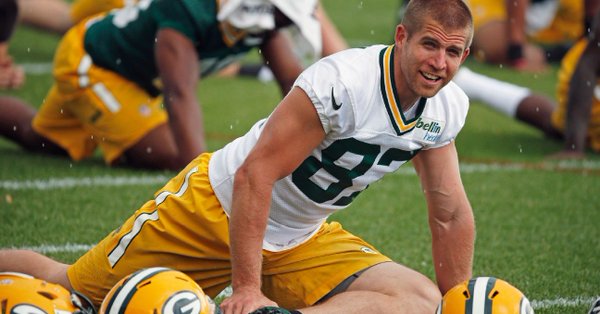
Article reposted from ESPN
Author: Jason Wilde
When Jordy Nelson accepted the Comeback Player of the Year award at the NFL Honors event on the eve of Super Bowl, his brief acceptance speech included a thank you to two guys most of the viewing public had never heard of.
He referred to them only as “Nate” and “Flea” — considering the Green Bay Packers star wide receiver spent just 38 seconds speaking, perhaps he didn’t have time for their last names — but Nelson made it clear that athletic trainers Nate Weir and Bryan “Flea” Engel were instrumental in the remarkable season (97 receptions, 1,257 yards, an NFL-best 14 touchdown catches) he had in 2016.
And while it was obvious from his quick stage right exit that he didn’t want to spend another second in front of the audience, Nelson said this week that winning the award was important to him as a way to recognize what Engel and Weir did to help him overcome the torn ACL in his right knee that wiped out his 2015 season and put the rest of his career in doubt.
“I wanted to win the award for those guys,” Nelson said during an appearance on ESPN Wisconsin’s “Wilde & Tausch” earlier this week. “Because they put in a lot of work behind the scenes.”
Nelson, who considered his comeback a team effort from the very beginning, credits Engel and Weir not only with getting him through the grueling rehabilitation process throughout the 2015 season but with keeping him on the field for all 16 regular-season games after limited work in training camp.
Nelson did miss the Packers’ NFC Divisional playoff win over the Dallas Cowboys on Jan. 15, but it wasn’t because of his knee — it was because of broken ribs suffered in the team’s Jan. 8 NFC wild-card playoff win over the New York Giants.
“I didn’t miss a practice until I broke my ribs and then obviously ended up missing the Dallas game,” Nelson said. “That was one of the things I was most happy about, being out there on the practice field every week, every day, not missing one of those and being able to perform on Sundays.”
Nelson did more than perform. At age 31, he showed that he’s still an elite-level player, putting up numbers that compared favorably to his 2014 performance (98 receptions for 1,519 yards and 13 touchdowns).
Nelson said his approach to rehab was to view it like a typical football season, just with an unusual workout regimen set by Engel and Weir. The goal was to be ready for the Sept. 11 regular-season opener at Jacksonville, which he met. After that, Nelson and Weir had a daily program designed to regain his pre-injury form and keep him healthy for the entire season.
“Nate and I had a schedule all season of what we wanted to do Monday, Tuesday, Wednesday, Thursday, Friday, Saturday in order to be ready for Sunday, and we stuck to it for 20-some weeks and never skipped a beat,” Nelson said. ‘And I think that’s why I was able to progress throughout the season, continue to improve and stay healthy.”
Nelson admitted that he became frustrated at times with the Packers’ conservative approach to his comeback during the offseason — general manager Ted Thompson, coach Mike McCarthy and team physician Dr. Patrick McKenzie were varying degrees of cautious with him — but said he, Engel and Weir always felt good about their plan.
“The trainers and I were on the same page,” Nelson said. “You have the coaching staff and management upstairs, and then you’ve got Doc, who’s extremely conservative — which we hate, but we love at the same time because he takes care of our bodies [when] at the same time we want to go out there and play and practice. So it was a battle from that aspect.
“When we got to OTAs [in May], [the team] kind of backed me off and we kind of regressed in terms of what they were letting me do. So that was the frustrating part of trying to communicate with everyone else. The trainers and myself were on the same page, but trying to get everyone else to understand what I had been doing, what I was capable of doing and allowing me to do that. We eventually got to it. It took some time, some conversations, but we got to that point and we ended up ready for Week 1. At the end of the day, that’s what our goal was.”
While Weir and Engel got Nelson ready physically, it was up to him to get ready mentally — something that, in retrospect, he admitted was just as arduous at times, especially for the 2015 home opener against the Seattle Seahawks and for the season-ending NFC Divisional loss at Arizona, when the Packers were down to two healthy wide receivers at game’s end.
“When we opened up at home against Seattle … it really sucks when you’re walking down the hallway [outside the home locker room] and they [his teammates] take a right and go down the tunnel [to the field] and you keep walking straight to go up the elevator to the players’ suite in the south end zone. That was not the most enjoyable.
“And then the Arizona playoff game was another one. Those are the games you want to play in, and we got banged up with Davante [Adams] getting hurt in the Washington game [the previous week], Randall [Cobb] got hurt early in that [Arizona] game. We’re running thin on guys, and I’m just standing there. You want to be out there to help the guys and win games and make plays. Those were the games that really hit me in the gut last year of not being able to be out there playing.”
